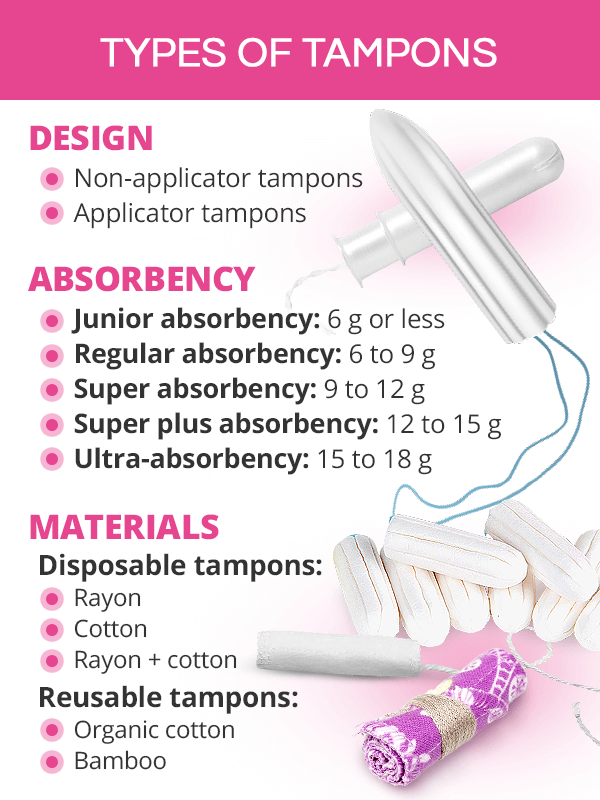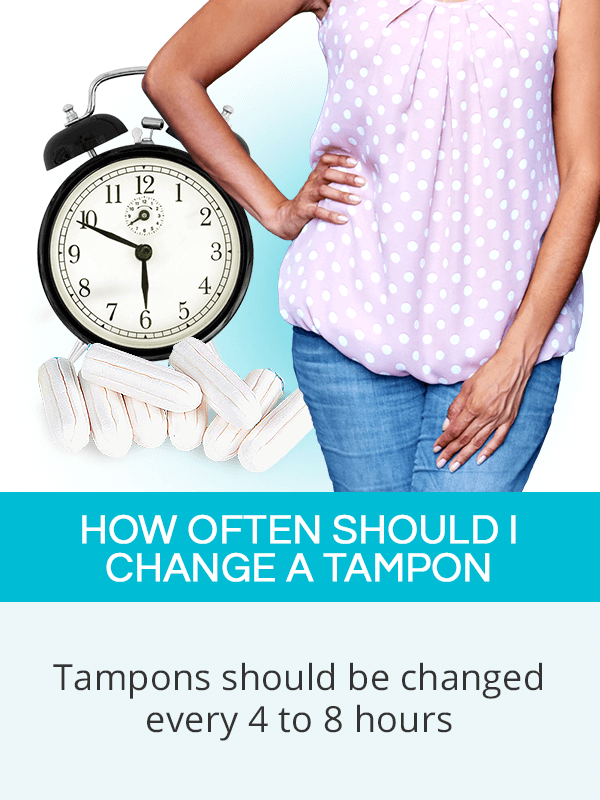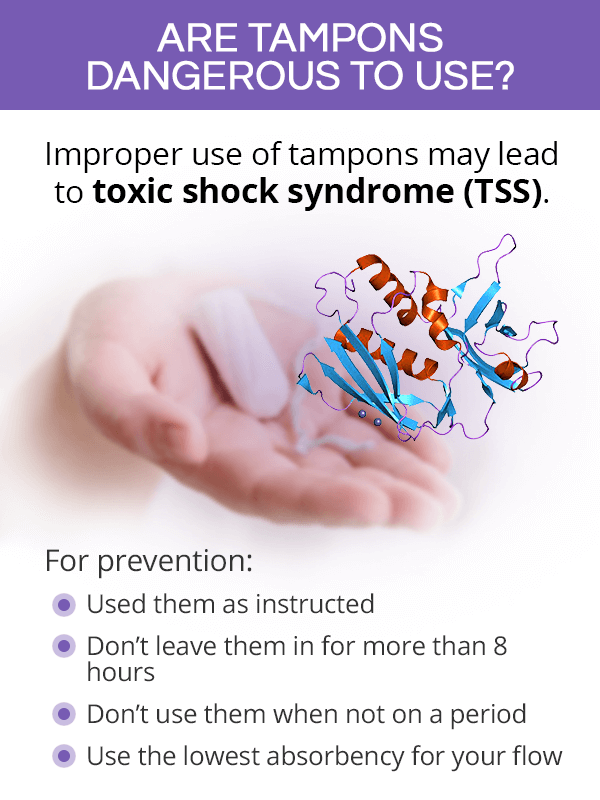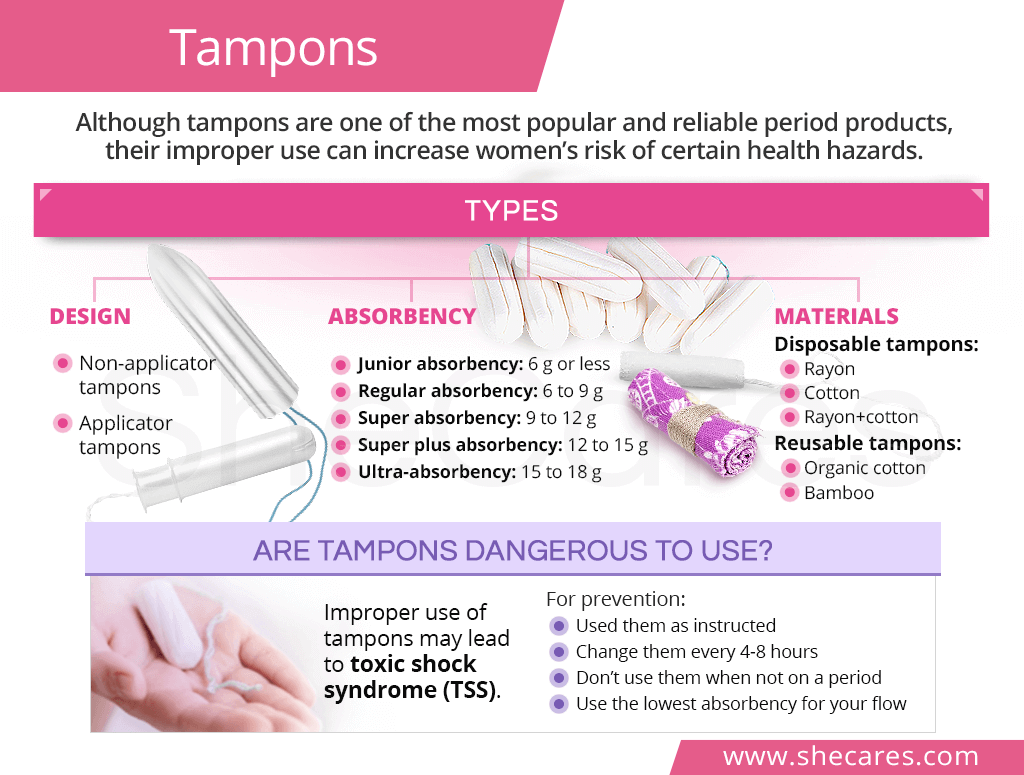What’s a Tampon?
A tampon in a type of period product designed to be inserted in the vagina to absorb menstrual discharge.
It is estimated that up to 86% of menstruating women use tampons as their go-to sanitary product, with feminine pads taking second place.1 In medicine, tampons are also used to control bleeding during surgery.
Tampons are available virtually everywhere, including supermarkets, pharmacies, local convenience stores, and online. Depending on their type and brand, the price of tampons ranges from $4-6 per box, or higher for organic tampons.
Types of Tampons

Tampons can vary in terms of their design, absorbency, and materials they are made with. They are as follows:
Tampon Design
All tampons consist of an absorbent, cylindrical stick with a string to facilitate its removal. They differ in terms of how they are inserted in the vagina, including:
- Non-applicator tampons, also called digital tampons, are inserted by finger.
- Applicator tampons come with plastic or cardboard applicator to ease insertion.
Tampon Absorbency
Tampons can also vary in terms of their absorbency, which corresponds with their size. Tampon manufacturers are required to maintain standard tampon absorbency ratings due to the risk of toxic shock syndrome, which is discussed below. They include the following five absorbency ratings:2
Junior (light) absorbency tampons absorb 6 grams or less of menstrual blood; they are generally ideal for the last few days of a period or for women with scanty periods.
Regular absorbency tampons absorb 6 to 9 grams of menstrual discharge; they might be the best choice for women with regular periods.
Super absorbency tampons absorb from 9 to 12 grams of period blood; they might be most appropriate during the first few days of a period.
Super plus absorbency tampons absorb from 12 to 15 grams of menstrual blood; they might fit the needs of women with heavy periods.
Ultra-absorbency tampons absorb from 15 to 18 grams of menstrual discharge; they may provide protection for women with very heavy periods.
What's in Tampons?
Nowadays, what are tampons made of is much more strictly regulated than before.
Disposable tampons are either made of rayon (the only synthetic material approved for use in the United States); a combination of rayon and cotton; or cotton alone. Many brands also include perfumes in their tampons.
Reusable tampons are usually made with organic cotton fabrics or crocheted with cotton or bamboo yarn. They are much less popular than the disposable ones, and sufficient data on their safety is lacking.
Today's tampons pass through a chlorine-free bleaching process, which is a safer alternative to old bleaching methods that evoked higher levels of dioxin, a potential carcinogen, in tampons. Although highly regulated by the Food and Drug Administration (FDA), trace amounts of dioxin may still be present in tampons, including organic tampons.3
How Often Should I Change a Tampon?

How often a woman should change her tampon will greatly depend on her menstrual flow. In the first two to three days of a period, flow tends to be more abundant. As such, she may need to change a tampon more frequently. Whereas, toward the end of a period, flow tends to be lighter, thus calling for less frequent changes.
However, official recommendations regarding proper menstrual hygiene call for a change every four to eight hours according to a woman's flow.4 Keeping a tampon for longer than that or overnight may lead to potentially serious consequences, as seen below.
Are Tampons Dangerous to Use?

Concerns regarding tampons' safety relate to the cases of toxic shock syndrome (TSS) among women using them, a rare but potentially fatal disease. While most women will not get TSS, staying informed about safe tampon use is of the essence.
Tampons Safety in the Past
In the late 1970s, tampon manufacturers began using four types of synthetic fibers to increase their products' absorbency, commercializing tampons for overnight use.3 It was observed that those synthetic materials may promote the growth of certain bacteria, which could cause the release of toxins into the body and, consequently, lead to TSS.
Tampons Safety Today
The number of TSS cases has significantly decreased in the last two decades, mainly thanks to the FDA's restrictions on what is in tampons, including banning the use of three of the four synthetic fibers linked to TSS. The FDA also created official guidelines on safe tampon use,including the following:5
- Use tampons are instructed on the package, including proper hand washing.
- Use tampons only during a period.
- Change tampons every 4 to 8 hours (never exceed the 8-hour mark).
- Use the lowest absorbency tampon for your menstrual flow.
- Avoid using tampons overnight.
- Alternate between using tampons and menstrual pads.
Also, it is important to note any symptoms that might be indicative of TSS, like sudden fever, vomiting, diarrhea, or a rash.
Key Takeaways
With such an abundance of brands, prices, and features,which tampons are the best is a matter of a woman's personal preference. However, because the choices she makes can impact her health, they should be made based on solid and reliable information.Tampons are one of the most popular period products alongside sanitary pads. They come in a rich variety of types, including with or without an applicator; disposable or reusable; as well as light to ultra-absorbent. They are usually made with rayon, cotton, or their combination. To prevent toxic shock syndrome, women are recommended to change their tampons every 4 to 8 hours and avoid overnight use. With proper menstrual hygiene practices, tampons can continue serving as a safe, reliable, and convenient sanitary product throughout women's menstruating years.
Sources
- Planned Parenthood. (n.d.). How do I use tampons, pads, period underwear, and menstrual cups? Retrieved May 25, 2020 fromhttps://www.plannedparenthood.org/learn/health-and-wellness/menstruation/how-do-i-use-tampons-pads-and-menstrual-cups
- Sutter Health. (n.d.). Tampons. Retrieved May 25, 2020 fromhttps://www.sutterhealth.org/health/teens/female/tampons
- The University of Texas at Austin. (n.d. ). Retrieved May 25, 2020 fromhttps://uthealthaustin.org/blog/period-products
Footnotes:
- Environmental Health Perspective. (2014). A Question for Women's Health: Chemicals in feminine Hygiene Products and Personal Lubricants. Retrieved may 25, 2020 from https://www.ncbi.nlm.nih.gov/pmc/articles/PMC3948026/
- FDA. (2005). Menstrual Tampons and Pads: Information for Premarket Notification Submissions (510(k)s) - Guidance for Industry and FDA Stuff. Retrieved may 25, 2020 fromhttps://www.fda.gov/regulatory-information/search-fda-guidance-documents/menstrual-tampons-and-pads-information-premarket-notification-submissions-510ks-guidance-industry#7a
- National Center for Health Research. (n.d.). Tampon Safety. Retrieved may 25, 2020 from http://www.center4research.org/tampon-safety/
- Office on Women's Health. (2018). Your menstrual change. Retrieved may 25, 2020 from https://www.womenshealth.gov/menstrual-cycle/your-menstrual-cycle
- FDA. (2018). The Facts on Tampons – and How to Use Them Safely. Retrieved may 25, 2020 from https://www.fda.gov/consumers/consumer-updates/facts-tampons-and-how-use-them-safely
